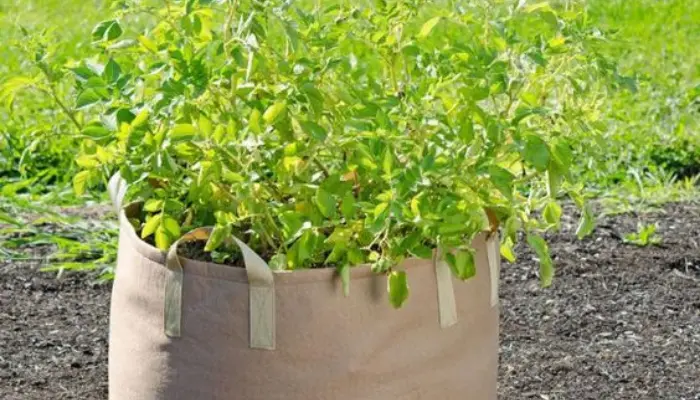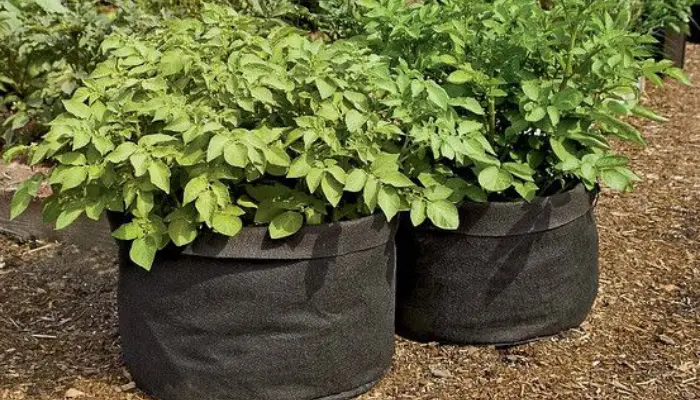What Size Grow Bag For Vegetables
A grow bag for vegetables is a lightweight container made from breathable fabric, perfect for growing veggies in small spaces like balconies or urban gardens.
These bags come in various sizes, ranging from small to large, catering to different types of plants and gardening spaces. The fabric construction allows for proper soil aeration, promoting healthy root development by preventing waterlogging and root circling.
One of the significant advantages of grow bags is their portability. Whether you have a small balcony garden or a spacious backyard, grow bags can be easily moved and rearranged to optimize sunlight exposure and space utilization.
Additionally, grow bags are versatile and can develop various plants, including vegetables, herbs, flowers, and small fruit trees. They’re trendy among urban gardeners and those with limited gardening space, as they offer a convenient solution for cultivating plants in small areas.
By providing optimal drainage, aeration, and portability, grow bags have revolutionized container gardening, making it accessible to a broader range of gardening enthusiasts.

Benefits of Grow Bags
Grow bags offer several advantages over traditional pots or containers, making them a popular choice among gardeners of all levels of expertise. Here are some of the key benefits:
Excellent Drainage
The breathable fabric construction of grow bags promotes superior drainage, preventing waterlogged soil and ensuring adequate oxygenation of the roots. This helps prevent issues like root rot and fungal diseases, leading to healthier plants.
Air Pruning
Unlike traditional pots, where roots can become pot-bound and spiral around the container, grow bags promote air pruning. As roots grow to the edge of the bag and are exposed to air, they naturally prune themselves, stimulating the growth of dense, fibrous root systems. This results in more robust, more resilient plants with increased nutrient uptake.
Portability
Grow bags are lightweight and portable, making them easy to move around as needed. Whether rearranging your garden layout, chasing the sun for optimal light exposure, or simply needing to protect your plants from harsh weather conditions, grow bags offer flexibility and convenience.
Space Efficiency
Grow bags utilize space more efficiently than traditional pots, allowing you to grow more plants in a given area. Their upright design and minimal footprint make them ideal for balconies, patios, and small gardens where space is limited.
Versatility
Grow bags can grow various plants, including vegetables, herbs, flowers, and ornamentals. Whether growing tomatoes, peppers, lettuce, or strawberries, there’s a grow bag size and type to suit your needs.
Cost-Effectiveness
Besides being affordable and readily available, grow bags are reusable and durable, providing long-term value for money. With proper care and maintenance, a single grow bag can last for multiple growing seasons, making it a sustainable choice for environmentally-conscious gardeners.
Choosing the Right Size Grow Bag
Selecting the appropriate size grow bag is crucial for the health and productivity of your plants. The size of the grow bag directly impacts the amount of space available for root growth, affecting your plants’ overall vigour and yield. Here are some factors to consider when choosing the right size grow bag.

Type of Plant
Different plants have varying space requirements and root depths. Consider the mature size of the plant and its root system when selecting the size of the grow bag. For example, small, compact plants like herbs and salad greens can thrive in smaller grow bags, while more significant, sprawling plants like tomatoes and peppers may require larger containers.
Root Depth
Some plants, such as carrots and potatoes, have deep root systems that require ample vertical space to grow. Choose to produce bags with sufficient depth to accommodate the root length of your plants without restriction.
Number of Plants
Determine how many plants you intend to grow in each grow bag. Overcrowding can lead to water, nutrients, and sunlight competition, resulting in stunted growth and reduced yields. Ensure that each plant has adequate space to spread out and thrive.
Available Space
Consider the size of your gardening area and the space for placing grow bags. If you have limited space, opt for smaller grow bags arranged vertically or horizontally to maximize space utilization.
Climate and Growing Conditions
Consider the local climate and growing conditions when choosing the grow bag size. In hot, dry climates, larger grow bags with greater soil volume can help retain moisture and prevent rapid drying. Conversely, smaller grow bags may warm up in cooler climates more quickly, promoting faster root growth and plant development.
Ideal Sizes for Different Vegetables
Different types of vegetables have varying space requirements and root depths, necessitating different sizes of grow bags for optimal growth and yield. Here’s a breakdown of the ideal grow bag sizes for various vegetables.
Small Vegetables:
- Leafy Greens: Vegetables like lettuce, spinach, and kale thrive in smaller grow bags ranging from 1 to 5 gallons. These compact plants have shallow root systems and do well in containers with limited space.
- Herbs: Culinary herbs such as basil, cilantro, and parsley are also preferred in smaller grow bags, typically ranging from 1 to 3 gallons. These herbs are often grown for their leaves and can be harvested frequently for necessitatinz.
Medium Vegetables
- Tomatoes: Determinate varieties of tomatoes, as well as cherry tomatoes, perform well in medium-sized grow bags ranging from 5 to 10 gallons. These plants have moderate root depth and benefit from ample soil volume to support fruit development.
- Peppers: Bell peppers, chilli peppers, and other sweet or hot pepper varieties thrive in medium-sized grow bags, typically ranging from 5 to 7 gallons. These plants have shallow to moderate root systems and do well in containers with good drainage.
Large Vegetables
- Potatoes: Potatoes are a popular choice for large grow bags due to their extensive root systems and high yield potential. Choose grow bags with a capacity of 10 gallons or more to accommodate the root depth and allow room for tuber formation.
- Squash: Vining vegetables like zucchini, butternut squash, and pumpkins require large grow bags with capacities ranging from 10 to 20 gallons or more. These plants have sprawling growth habits and benefit from ample soil volume to support vigorous growth and fruit development.
Small Grow Bags: When to Use Them
Small grow bags have their own set of advantages and limitations, making them suitable for specific gardening situations. Here’s when you might consider using small grow bags
Limited Space
If you have a small balcony, patio, or windowsill garden with limited space, small grow bags are an excellent choice. Their compact size allows you to maximize space utilization and grow a variety of plants in a confined area.
Portability
Small grow bags are lightweight and easy to move, making them ideal for gardeners who need to rearrange their garden layout frequently or protect plants from extreme weather conditions. You can easily relocate small grow bags to optimize sunlight exposure or create microclimates for temperature-sensitive plants.
Early Harvests
Small grow bags are perfect for starting plants indoors or in a greenhouse before transplanting them outdoors. They allow you to get a head start on the growing season and enjoy early harvests of herbs, salad greens, and other quick-growing crops.
Experimentation
If you’re new to gardening or want to experiment with different plant varieties, small grow bags offer a low-risk, low-cost option. You can try out new crops, test different growing techniques, and learn from your experiences without committing to larger containers or garden plots.
Large Grow Bags: Maximizing Yield
Large grow bags are ideal for maximizing yield and accommodating plants with extensive root systems. Here’s why you might consider using large grow bags in your garden:
Ample Soil Volume
Large grow bags provide ample soil volume for plants to develop extensive root systems, resulting in healthier, more productive plants. This extra soil capacity allows plants to access nutrients and water more efficiently, leading to increased growth and yield.
High Yield Potential
With their generous size, large grow bags offer the potential for high yields, making them ideal for growing crops like potatoes, squash, and other vining vegetables. These plants require plenty of space to spread out and produce abundant harvests, which large grow bags can provide.
Space Efficiency
Despite their large size, grow bags are space-efficient and can be arranged vertically or horizontally to maximize garden space. This makes them suitable for small gardens, urban environments, and other limited-space settings where traditional gardening may not be feasible.
Portability
While large grow bags may be heavier than smaller sizes, they’re still relatively easy to move compared to traditional garden beds or containers. This flexibility allows you to adjust your garden layout as needed and optimize growing conditions for your plants.
However, it’s essential to consider the limitations of large grow bags. They require more soil, water, and nutrients than smaller sizes and may only be suitable for some types of plants or gardening situations. Additionally, their size may be challenging to manage in small spaces or indoor environments.
Conclusion
Choosing the right size grow bag is essential for successful vegetable gardening. Consider the space available, the type of vegetables you want to grow, and their root system requirements. Whether you opt for small, medium, or large grow bags, ensuring adequate space for root development is critical to maximizing yields and promoting healthy plant growth.
FAQs
What size grow bag do I need for vegetables?
For vegetables, the size of the grow bag depends on the type. Small veggies like herbs need 1-5 gallons, medium ones like tomatoes need 5-10 gallons, and larger ones like potatoes need 10-20 gallons or more.
What vegetables can you grow in 5 gallon grow bags?
In 5-gallon grow bags, you can grow a variety of vegetables such as tomatoes, peppers, herbs, lettuce, spinach, radishes, and some dwarf varieties of beans and peas.
What vegetables can I grow in 7 gallon grow bags?
In 7-gallon grow bags, you can grow vegetables like tomatoes, peppers, cucumbers, carrots, beets, and certain varieties of squash and eggplant.
How many cucumber plants per 7 gallon grow bag?
In a 7-gallon grow bag, you can typically grow one cucumber plant.






